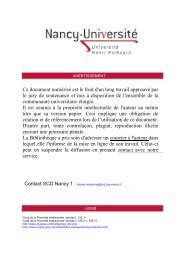Ce document numérisé est le fruit d'un long travail approuvé par le ...
Ce document numérisé est le fruit d'un long travail approuvé par le ...
Ce document numérisé est le fruit d'un long travail approuvé par le ...
You also want an ePaper? Increase the reach of your titles
YUMPU automatically turns print PDFs into web optimized ePapers that Google loves.
Peroxisome proliferator-activated receptors are key regulators in cel! differentiation 151<br />
largely used in the treatment of<br />
hypertriglyceremia and combined<br />
hyperlipidemia.<br />
Nonsteroidal<br />
antiinflammatory drugs (NSAIDs) have also<br />
been shown to bind to ppARa [36]. In<br />
addition, coDjugated lino<strong>le</strong>ic acid isomers,<br />
oxidized phospholipids and a new<br />
thiazolidinedione derivative were recently<br />
shown to be high affinity synthetic ligands for<br />
ppARa [37-39]. ppAR~/() is activated by<br />
polyunsaturated fatty acids [12]. ppARr is<br />
activated by arachidonic acid metabolites<br />
derived from the cyclooxygenase and the<br />
lipoxygenase pathway such as 15-deoxy-~-12,<br />
14 prostaglandin J2 [40, 41] and 15<br />
hydroxyeicosatetraenoic acid respectively [42,<br />
43]. Other ligands like 9- and 13<br />
hydroxyoctadecadienoic acid derive from<br />
fatty acids of oxidized LDL [42]. Synthetic<br />
ligands, members of the thiazolidinedione<br />
family are agonists for ppARr [44]. These<br />
drugs are used in treatment of insulin<br />
resistance and type 2 diabetes. In addition,<br />
indomethacin and ibubrofen, two well-known<br />
NSAIDs, function as ligands for ppARr [36].<br />
Phosphorylationldephosphorylation<br />
This process is an important mechanism of<br />
ppAR activation ; it is also necessary for<br />
others transcription factors [21]. However,<br />
ppARa is activated by phosphorylation as<br />
does <strong>est</strong>rogen receptor for exemp<strong>le</strong> whereas<br />
transactivation of ppARr implicates<br />
dephosphorylation within the AF-I domain.<br />
Rurnan ppARa is phosphorylated at serine 12<br />
and 21 in the AF-l domain by MAPK<br />
pathway [45]. Phosphorylation is insulin<br />
dependent [46] and is modulated by an<br />
unknown inhibitor under the control of Janus<br />
kinase 2/Signal Transducer and Activator of<br />
Transcription 5b (JAK2/STAT5b) himself<br />
regulated by growth hormone stimulation<br />
[47]. Ciprofibrate treatment in rat cells<br />
enhances phosphorylation of ppARa [48].<br />
Unexpectedly, the PPARa phosphorylation<br />
<strong>le</strong>ads to a decrease ofacyl-coA oxidase, a<br />
peroxisomal fatty acid ~-oxydation marker<br />
[48]. In addition, peroxisome proliferators<br />
enhance extracellular signal-regulated kinase<br />
1 and 2 (ERK1 and ERK2) phosphorylation at<br />
tyrosine residues [49]. ppARrI and 12 are<br />
phosphorylated at serine residues 82, 84 and<br />
112, 114 -respectively via MAPK pathway<br />
within the AF-1 domain (these respective<br />
serine residues may represent the same<br />
MAPK consensus sequence) [50, 51]. In<br />
preadipocytes and adipocytes,<br />
phosphorylation of ppARr is stimulated by<br />
insulin and is dependent on the MAPK<br />
pathway [52, 53] whereas prostaglandin F2<br />
inhibits MAPK-dependent phosphorylation of<br />
ppARr [54]. The ppARr phosphorylation<br />
process decreases both ligand binding and<br />
transcriptional activities of target genes and<br />
ultimately arr<strong>est</strong>s the preadipocyte<br />
differentiation into adipocytes [50]. In<br />
addition, phosphorylation at serine residues is<br />
achieved by different ways : phosphorylation<br />
of ppARr1 at serine 84 occurs by ERK2 and<br />
c-jun N-terminal kinase (JNK) [51, 55] ; at<br />
serine 82, by stimulation of epidermal growth<br />
factor receptor via the MAPK-dependent<br />
pathway [53]. Stress protein kinase as<br />
JNKIStress-Activated Protein Kinase<br />
phosphorylates ppARrl in a MAPK<br />
independent manner and subsequently lowers<br />
ppARrl transcriptional <strong>le</strong>vel [55]. Finally<br />
ppAR~/() could be phosphorylated even<br />
though no MAPK consensus sequence has<br />
been found and therefore phosphorylation is<br />
processed by a MAPK independent pathway<br />
[51].<br />
PPARS AND LIPID METABüLISM<br />
Fatty acid metabolism<br />
Various target genes implicated in lipid<br />
catabolism mainly in liver are under the<br />
control of PPARa. Fatty acids are re<strong>le</strong>ased<br />
from lipoprotein <strong>par</strong>tic<strong>le</strong>s through the activity<br />
of lipoprotein lipase and then taken up by the<br />
cells.PPARa-dependent lipoprotein lipase
















